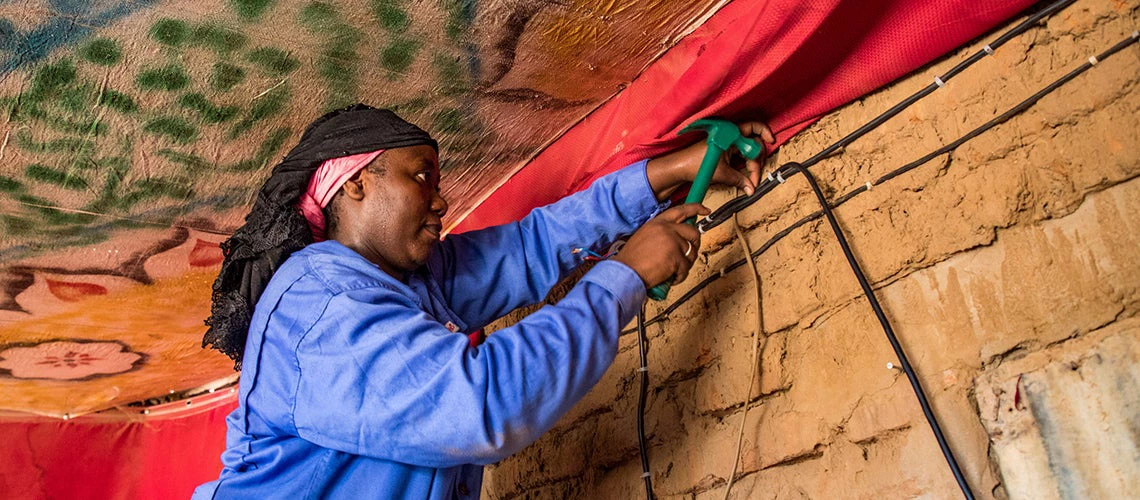 Adaouia Birema works at installing electricity at a client's house in Chad. Photo: Vincent Tremeau/World Bank
Adaouia Birema works at installing electricity at a client's house in Chad. Photo: Vincent Tremeau/World Bank
Located in the subregions of West and Central Africa, the Lake Chad region is a highly heterogenous and socioeconomically integrated area that is experiencing a violent security crisis linked to Boko Haram and affiliated groups. It started in Maiduguri, in North East Nigeria, in 2009 and then rapidly spread to neighboring Cameroon, Niger and Chad.
The conflict has exacerbated deep-rooted vulnerabilities and triggered an acute humanitarian crisis, widespread insecurity, substantial displacements of population and the disruption of economic activities. On top of this, the widespread insecurity has deeply affected the living conditions of the population in the areas of education, health, local governance, economic exchanges, social activities, and security.
In November 2021, the World Bank completed the Lake Chad Regional Risk and Resilience Assessment (RRA), meant to diagnose the key factors of fragility and resilience in the Lake Chad region along with operational recommendations for the Bank to address and mitigate fragility and support resilience.
The standout of this assessment was to debunk and unravel common myths and misunderstandings about the Lake Chad region , which is key to frame the crisis correctly and, consequently, to impact discussions about appropriate responses. These myths include:
- The use of the “Boko Haram” label for a host of complex and quite different realities (from one country to another and one locality to another) does not do justice to the root causes behind the insurgency . The insurgency is the consequence of preexisting conditions and structural drivers of fragility, triggered by sudden events such as insecurity in the neighborhood and the economic crisis, but it became, in turn, a cause of continued crisis.
- The inevitable “disappearance” of the lake is often presented as the main cause of the crisis and of a variety of social ills. Recent scientific analyses have debunked the widely held view that the lake is drying up, showing instead that water levels fluctuate and that the lake has partly replenished since its low of the 1970s and 1980s. These studies therefore unravel the myth that the current crisis in the region is linked to the disappearance of the lake. More than the shrinking of the lake, the issue at hand lies with the impact of climate change, with the occurrence of extreme weather and variability.
- High population growth tends to be over blamed for violence and conflict. Experience suggests that channels that translate high population growth or high population density into violent conflict are specific, relating in some context to the role and status of youth and the gap between expectations and day-to-day struggles. In the context of the Lake Chad region, high population growth is indeed a challenge, but it should not be seen as the sole cause of violence and should instead be considered in relation to the other structural dimensions of the crisis.
- The Bring Back Our Girls campaign was lauded for bringing unprecedented international attention to usually underreported issues involving girls, Africa, and girls in Africa. However, this sudden but short-lived international media coverage had little effect on the quality and effectiveness of the response in addressing the root causes of the conflict.
- Women as “wives, weapons and witnesses.” Women have been particularly affected by the ongoing conflict and they have suffered different forms of violence. The conflict has also reconfigured women’s role in society, as they had to engage in new economic activities and take on decision-making roles, in the absence of men who were forced to flee or were killed. Women also played a supporting role within the insurgency and vigilante groups, some voluntarily, others not. This requires a much more diverse perspective to understand the role and impact of women in conflict-settings.
- The reasons why youth joined the ranks of armed groups in the context of their aspirations are also explored and point to the variety of different push and pull factors and the need for a more diverse and nuanced approach.
Although the shrinking of Lake Chad continues to dominate the headlines and, while media attention mostly focuses on the insurgency, it is clear that the crisis unfolding in the Lake Chad region is complex, multidimensional, and also very often misunderstood.
The Lake Chad regional RRA helped shape a regional consensus and dialogue on the causes and impacts of the conflict in the region, thanks to a comprehensive consultations process, including a series of virtual conversations on fragility and resilience in the Lake Chad region, as a collaboration between Chatham House’s Africa Program and the Bank.
On the operational side, the assessment’s findings and recommendations inform the design and implementation of regional programs, aimed at addressing the root causes of the conflict and supporting resilience, including the ongoing Lake Chad Region Recovery and Development Project, whose objective is to contribute to the recovery of the region by supporting regional coordination and crisis monitoring, connectivity and agricultural livelihoods in selected provinces of Cameroon, Chad and Niger.
The Lake Chad RRA was a multi-country process that offered a unique opportunity to reflect internally and externally about shared challenges, commonalities but also differences between countries. It also showed that the Bank has a convening power to foster regional coordination and dialogue.
Published in French in Nasikiliza.


Join the Conversation